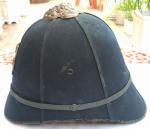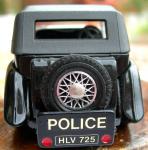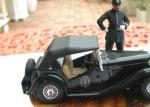-
Posts
13,225 -
Joined
-
Last visited
-
Days Won
22
Content Type
Profiles
Forums
Blogs
Gallery
Events
Store
Everything posted by Mervyn Mitton
-

Zulu items
Mervyn Mitton replied to helen's topic in Great Britain: Militaria: Badges, Uniforms & Equipment
-

Zulu items
Mervyn Mitton replied to helen's topic in Great Britain: Militaria: Badges, Uniforms & Equipment
-

Zulu items
Mervyn Mitton replied to helen's topic in Great Britain: Militaria: Badges, Uniforms & Equipment
-

Zulu items
Mervyn Mitton replied to helen's topic in Great Britain: Militaria: Badges, Uniforms & Equipment
-

Zulu items
Mervyn Mitton replied to helen's topic in Great Britain: Militaria: Badges, Uniforms & Equipment
Helen showed a good rest - these are a few more - they allowed the men to show great variety in the carving. Probably all are around the 100 year old group. -
Thomas - it goes back to the 1860's. The Germans - or, at that time the Prussians - were the World leaders in Army. Great Britain was the leader with Navy. The time had come to change the original uniform of 1829 and it was decided the twin tailed 'swallow' coatee would be replaced with a tunic - based on the German one of the period. This originally came to the knees, but was later shortened. The German helmet was also adopted - by both our Police and Army. The Police still wear the helmet - or, as Leigh points out, perhaps for not much longer. The blue military helmet is still worn by some Regt's for Bands et.. Traditionally, the Army have a pointed spike for Infantry and a ball top for Artillery. Some Police Forces still wear a ball top finial to the helmet. Yes, they are heavy - and yes - they do fall off in fights and when running - although there is a chin strap which is fairly good and for riots a special double chin strap. The fact is that they are part of our history - take the helmet away - use only flat caps and everyone looks like a traffic warden Hope that answers the query ? Mervyn
-
I'll also start another thread on general police headgear - everyone , please join in with the interesting - but more common ones. Not that this could be called 'common'. When the Metropolitan Police first 'marched out' in 1829 a lot of thought had gone into their uniform. The French Revolution was not long before and there was great fear in England of having a uniformed body of men - outside of the military. They decided to make the uniform very similar to the civilian dress of that period and the men - of any importance - wore top hats. The first pattern were larger than this one and had a swelling top - which had inside a framework of cane. The 'bright' idea was that if the constable was chasing someone, he could throw the hat down and use it as a step to climb walls. That didn't last long - they were far too heavy. Top hats continued into the 1860's when the first pattern of helmet was introduced. Some of the County Forces had a smaller hat than the Met. and I think this is one - probably dates from the 1840 - 50's period. They are very rare today and this is the only one I have ever had the chance to buy. Always bear in mind the great number of films and TV programmes that have required period dress and they do come on the market and cause confusion. They are not fakes - intended to deceive for profit - but, rather copies.
-
I have a number of sets of items in the collection which will be better shown, some at a time. This is the first of some good Police models and shows the first Metropolitan Police Officer in 1829. I think these are Stadden's - the famous model makers and are in pewter. He is accurately modelled and shows the top hat of the period , a lantern, his rattle and on his left hip is his truncheon - they were carried in a leather case at that time. I will add another piece to start and, it would be good if anyone else can add as we go along.
-

Zulu items
Mervyn Mitton replied to helen's topic in Great Britain: Militaria: Badges, Uniforms & Equipment
-

Zulu items
Mervyn Mitton replied to helen's topic in Great Britain: Militaria: Badges, Uniforms & Equipment
-

Zulu items
Mervyn Mitton replied to helen's topic in Great Britain: Militaria: Badges, Uniforms & Equipment
Continuing this post of old items from Helen. These are examples of the famous Knobkerry - known in Zulu as an IWISA (e wee sa) - they are actually quite rare as they are in regular use and just haven't survived. The top one is an Iwisa - the one with a smaller head ia an IQUBANGA. This is more ceremonial and would be carried by a chief - or, Induna - when he was at home in his Kraal - and 'off duty' ! Many different woods could be used - Ironwood was always popular - very heavy. Very often they will have copper and brass at intervals along the shaft and some of the 'Kraal' ones have snuff boxes in the knob. I think we have one in the shop, ifso I will post. -

EARLY STH. AFRICA POLICE BADGES
Mervyn Mitton replied to Mervyn Mitton's topic in Police Forces of the World
Welcome back - Will. A rare badge - it's funny that the brass is always worn from over polishing. They used to use fine sand - I don't suppose that helps... -

Zulu items
Mervyn Mitton replied to helen's topic in Great Britain: Militaria: Badges, Uniforms & Equipment
'Washed' - I always work on the basis that every old spear, has probably been 'washed' about ten times. Zulus are warriors - the women do the work - they do the fighting !! Because , in Victorian times the men would not do manual labour, we brough indentured Indian labourers into Natal to do the menial work - being the fine workers they are - they now own most of Natal !! Les - I can only agree with your acute observations. When Shaka started his 'expansion' policy, the first thing that happened was that the clans and tribes near him moved away - and set-up what is now Swaziland. The further South the Impis went , the more they came into contact with the Xhosa's. Also a warlike tribe, they are traditional enemies of the Zulus. However, they could not match them in those early days and just merged in and became 'Zulus'. The ruling party in S.A. is the African National Congress (A.N.C.) and their leaders, including Nelson Mandela, are Xhosas. The result has been in recent years that the original central/Northern Natal districts where the King came from are Inkatha Freedom Party (I.F.P.) and the Southern areas are strongly A.N.C. - this has led to a lot of problems. Our new President - Jacob Zuma - is the first Zulu President and we are hopeful that will settle things down. Just an historical observation - the word, INKATHA , is actually the throne that the king traditionally sits on to make judgements. When a new King comes to the throne - every clan and village will cut reeds and send them to the King - this shows their acceptance and respect. The reeds are then woven into a giant rope - as thick as a man - and then this is coiled to about five feet high (150cm) . -

The use of Gold Sovereigns,
Mervyn Mitton replied to bigjarofwasps's topic in Coins & Commemorative Medallions
When did the Sovereign first start to be used ? I suppose in some ways, it must be descended from the Roman gold denarius?? -

1892 ZAR Republic 5/- PIECE
Mervyn Mitton replied to Mervyn Mitton's topic in Coins & Commemorative Medallions
You have good eyes - I hadn't noticed the little blob at the top. You are probably right that it was turned into a brooch. They had a nasty habit of taking suspenders off medals and doing the same. I suppose if they earned it, they have the right to do what they want ! -

CAP TALLIES IDENTIFICATION
Mervyn Mitton replied to Mervyn Mitton's topic in Great Britain: Research, Documentation & History
A few years ago we used to see them all the time - now they seem to have become rare - perhaps more in UK. I think that all good militaria seems to be scarce - is it more collectors or, people hanging on as good inflation investments ??



















